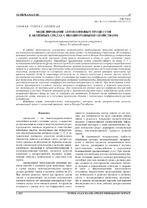Моделирование автоволновых процессов в активных средах с неоднородными свойствами

Date
2023Publisher
Another Title
Modeling of autowave processes in active media with inhomogeneous properties
Bibliographic entry
Гулай, А. В. Моделирование автоволновых процессов в активных средах с неоднородными свойствами = Modeling of autowave processes in active media with inhomogeneous properties / А. В. Гулай, В. А. Гулай, А. В. Дубовик // Системный анализ и прикладная информатика. – 2023. – № 3. – С. 17-22.
Abstract
В работе представлены результаты компьютерного моделирования процессов возбуждения и распространения автоволн в распределенных активных средах с неоднородными свойствами. Исследование автоволн методом клеточных автоматов выполнено на основе модели Винера–Розенблюта, в соответствии с которой каждый элемент активной среды может находиться в одном из трех состояний: покоя, возбуждения и рефрактерности. Разработан программный модуль «AutoWaveModel» на языке C++ c использованием библиотеки Qt и технологии OpenGL для моделирования динамических процессов возбуждения спиральных волн и пейсмейкеров. Неоднородность свойств активной среды в рассматриваемой модели задается, в частности, путем введения в поле (объем) моделирования определенного количества неактивных элементов, распределенных по случайному закону. Установлено, что распад автоволн происходит при введении порядка 30–60 % неактивных элементов от их общего количества в модели, причем, процесс распространения волны становится более устойчивым при повышении коэффициента распада активатора всех элементов. В качестве одного из факторов, создающих неоднородность активной распределенной среды, рассмотрено также изменение коэффициента распада активатора в ее объеме. При этом каждой ячейке модели присваивается случайное значение указанного коэффициента, лежащее в заданном промежутке от минимальной до максимальной величины. При значительной разнице величин коэффициента распада активатора в соседних областях активной среды и достаточно высоком пороге возбуждения происходит искривление фронта волны за счет ее ускорения или замедления. В данном случае наблюдается также разрушение волны, которая не в состоянии преодолеть область с пониженным коэффициентом распада активатора.
Abstract in another language
This paper shows the results of computer modeling of the processes of excitation and propagation of autowaves in distributed active media with inhomogeneous properties. The study of autowaves by the cellular automata method is based on the Wiener–Rosenbluth model, according to which each element of the active environment can be in one of three states: rest, excitation and refractoriness. The software module "AutoWaveModel" has been developed in C++ using the Qt library and OpenGL technology for modeling dynamic processes of excitation of spiral waves and pacemakers. The heterogeneity of the properties of the active environment in the model under consideration is set, in particular, by introducing into the field (volume) of modeling a certain number of inactive elements distributed according to a random law. It is established that the decay of autowaves occurs when about 30-60% of inactive elements are introduced from their total number in the model, moreover, the wave propagation process becomes more stable with an increase in the decay coefficient of the activator of all elements. As one of the factors creating heterogeneity of the active distributed environment, the change in the decay coefficient of the activator in its volume is also considered. In this case, each cell of the model is assigned a random value of the specified coefficient, lying in a given interval from the minimum to the maximum value. With a significant difference in the values of the activator decay coefficient in near areas of the active environment and a sufficiently high excitation threshold, the wave front is curved due to its acceleration or deceleration. In this case, the destruction of the wave is also observed, which is unable to overcome the area with a reduced decay coefficient of the activator.
View/
Collections
- № 3[8]
